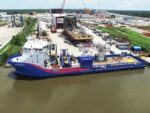In a significant move that could reshape Italy’s naval posture and defense-industrial base, the Italian Ministry of Defence is reportedly preparing to launch a feasibility study in 2026 for what could become the country’s first nuclear-powered aircraft carrier. If pursued, this would mark a historic departure from Italy’s traditionally conventionally powered fleet and signal ambitions to join the elite group of nations operating nuclear carriers.
Strategic Ambitions Behind the Nuclear Option
The decision to explore nuclear propulsion for an aircraft carrier reflects multiple converging strategic drivers. Chief among them is Italy’s desire to enhance its power projection capabilities within NATO and across the increasingly contested Mediterranean and Indo-Pacific theaters. A nuclear-powered carrier offers unmatched endurance—potentially operating for over 20 years without refueling—and greater electrical output for future high-energy weapons or advanced sensor suites.
Currently, only the United States and France operate nuclear-powered carriers—the former with its Nimitz- and Ford-class supercarriers and the latter with the Charles de Gaulle. Italy’s potential entry into this club would significantly elevate its status within NATO maritime operations and European defense initiatives such as PESCO (Permanent Structured Cooperation).
According to Italian defense sources cited by World Defence News, preliminary discussions are already underway within the Marina Militare (Italian Navy) and MoD planning offices. The formal launch of a funded feasibility study is expected in 2026 under Italy’s next multi-year defense investment plan (Piano di Programmazione Pluriennale per la Difesa).
Replacing or Complementing Cavour-Class?
Italy currently operates two aircraft carriers: the light carrier Cavour (CVH 550), commissioned in 2008, and the smaller amphibious assault ship/aircraft carrier hybrid
The new nuclear-powered design—if approved—could either replace Cavour by the mid-2030s or serve as a complementary flagship with extended blue-water reach. While no official displacement figures have been released yet, speculation suggests a vessel larger than Cavour‘s ~27,000-ton full load displacement—possibly approaching French Charles de Gaulle size (~42,000 tons) or even exceeding it if aligned with future F-35C compatibility or EMALS integration aspirations.
This would require not only major shipyard expansion at Fincantieri but also new support infrastructure at key naval bases like Taranto or La Spezia capable of handling nuclear vessels—a non-trivial undertaking involving environmental clearances and international regulatory compliance under IAEA oversight.
Nuclear Propulsion Challenges: Technology & Industrial Base Gaps
A critical hurdle lies in Italy’s lack of domestic experience with naval nuclear propulsion systems. Unlike France or Russia—which maintain indigenous reactor design capabilities—Italy has never operated a military-grade marine reactor. Its civilian nuclear energy program was effectively shut down after referenda in 1987 and again curtailed after Fukushima in 2011.
To bridge this capability gap, Rome may seek technology transfer partnerships with France’s Naval Group (builder of Charles de Gaulle) or potentially collaborate under broader EU defense-industrial frameworks. Alternatively, cooperation with U.S. contractors such as General Atomics or BWXT could be explored under NATO auspices—but such options would raise sovereignty questions over reactor control protocols.
Moreover, building a naval reactor program from scratch will require long-lead investments in specialized metallurgy, radiation shielding materials (e.g., boron steel), safety protocols training pipelines for naval engineers/reactor officers akin to U.S. Navy’s Nuclear Propulsion Officer Candidate School (NUPOC), as well as regulatory harmonization between civil atomic agencies and military authorities.
Budgetary Outlook & Political Willpower
The cost implications of developing a nuclear-powered carrier are substantial—likely exceeding €8–10 billion over two decades when factoring hull construction (~€4–5B), reactor development (~€1–2B), infrastructure upgrades (~€1B+), crew training pipelines (~€500M), and lifecycle sustainment costs.
While Italy has steadily increased its defense budget since Russia’s invasion of Ukraine—with FY2024 reaching ~€28 billion—the scale of investment required may necessitate multi-party political consensus across successive governments. The project could also face domestic opposition given past anti-nuclear sentiment among segments of Italian civil society.
A phased approach is likely: beginning with conceptual studies (2026–2028), followed by preliminary design contracts (~2030), reactor R&D partnerships (~2030–2035), prototype testing (~2035–2040), leading up to possible keel laying post-2040 if strategic conditions align favorably.
NATO Interoperability & Mediterranean Naval Balance
If realized, an Italian nuclear aircraft carrier would significantly alter Mediterranean maritime dynamics—especially vis-à-vis regional powers like Turkey (which is commissioning TCG Anadolu) or Egypt (operating Mistral-class LHDs). It would also enhance NATO’s ability to sustain persistent air-maritime presence without relying solely on U.S. CVNs during crises from North Africa to Eastern Europe.
- NATO Interoperability: A larger deck may enable cross-deck operations with U.S., UK or French fighters during joint exercises like Dynamic Manta or Neptune Strike.
- Crisis Response: Faster sortie rates enabled by higher electrical output could support drone swarms or directed energy weapons against saturation threats like loitering munitions or hypersonic glide vehicles.
- Sustainability: Nuclear propulsion offers logistical independence from vulnerable fuel supply chains during prolonged deployments beyond Suez Canal chokepoints into Indo-Pacific missions alongside EU Indo-Pacific strategies.
The Road Ahead: From Feasibility to Fleet Reality?
The announcement of an upcoming feasibility study does not guarantee eventual construction—but it marks an inflection point in Italian naval thinking. Whether driven by geopolitical ambition or industrial revitalization goals via Fincantieri/Leonardo-led consortia, Rome appears ready to explore capabilities once deemed out-of-reach due to technical complexity and political risk.
If successful—and backed by sustained funding—a future Italian CVN could enter service around mid-century (~2045). Until then, much depends on whether Rome can build both political consensus at home and technological bridges abroad while navigating nonproliferation sensitivities tied to military-reactor development within civilian democratic frameworks.









